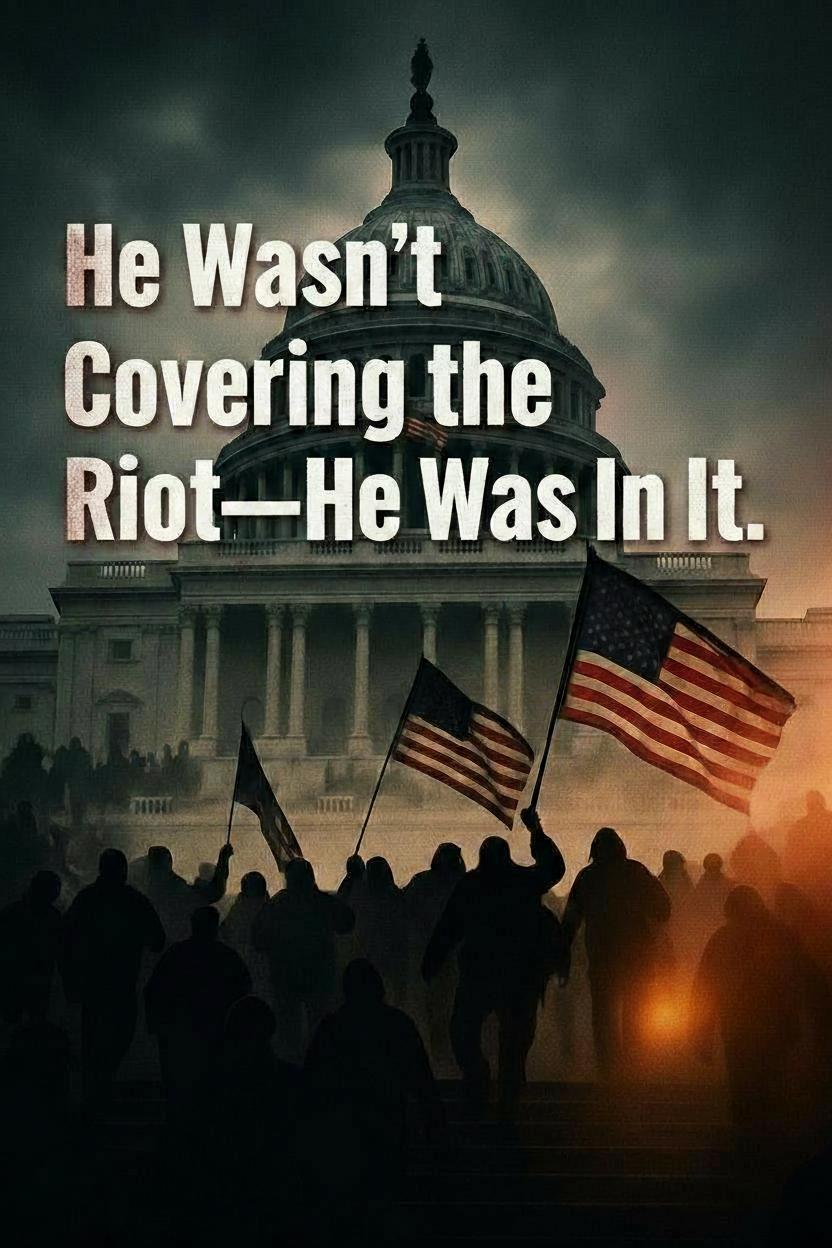From J6 to Journalism: Paul Mulholland’s Troubling Ties to Extremism
Prologue — The Branding Tells the Story
Before a single clip rolls or a word is spoken, Mulholland tells viewers exactly who he is. His livestream and channel branding open beneath a hammer-and-sickle logo—a symbol he uses repeatedly across his content. The image isn’t incidental; it’s identity. A professional journalist signals neutrality. Mulholland opens with political iconography synonymous with extremism and state propaganda.

This choice sets the tone for everything that follows. A journalist’s credibility begins with framing, and Mulholland’s self-branding frames him not as an observer of politics but as a participant in it. The following sections break down how his own words and actions confirm it.
Part I — The Standard: What Counts as Journalism at a Violent Event
Issue. When does being physically present at a riot qualify as journalism—and when is it participation dressed up with a camera?
Rule. Under widely accepted norms (SPJ Code; newsroom practice), a reporter covering civil unrest must:
- Identify as press (visible credentials, vests, or markings).
- Maintain observable separation from unlawful conduct.
- Document rather than advocate (no chanting or signaling).
- Comply with lawful orders and preserve footage as evidence (with verifiable audio/metadata).
- Prioritize safety protocols (PPE, situational awareness, non-embedded vantage).
Application. Failure on these prongs signals activism with a camera, not reporting. Mens rea (intent/identity) plus actus reus (embedded action) defeats the presumption of journalism.
Conclusion (Part I). Journalism is a function, not a costume. At riots, conduct is the credential.
Part II — The Record: What Mulholland Admits
Key fact pattern drawn from Mulholland’s own January 6th livestream narration (emphases added):
- B1 — Self-identification collapse. “I got to the Capitol on the 6th as a reporter that was a protester.”
Analysis: By his own label, he merges roles the SPJ Code demands remain separate. Identity is step one of independence. - B2 — No credentials in the breach crowd. He describes being at “the steps of the Capitol,” “these are the doors into the Capitol building,” and remaining amid the push when “they started pepper spraying people.” No mention of a PRESS vest, helmet tag, or lanyard; instead he notes wearing “goggles.”
Analysis: Embedded placement inside an active breach without visible press ID defeats observable neutrality and safety protocol. - B3 — Evidentiary failure. “My microphone was off the whole time… all the video I have is silent.”
Analysis: Audio is basic evidentiary integrity (commands, warnings, crowd intent). Self-nullified record = commentary, not reportage. - B4 — Situational unawareness. “I don’t know which entrance I was by though.”
Analysis: Professional newsgathering requires precise locationing for verification and timelines. Not knowing the entrance undermines claims of rigorous reporting. - B5 — Movement with the mob, not lateral to it. He narrates pressing near doorways “trying to get past [police]” crowds, “couldn’t really get through… too dense,” and “I got maced,” with pepper spray “on my lens.”
Analysis: Being caught in crowd surges and chemical exposure is consistent with participant proximity, not controlled press standoff distance. - B6 — Pattern and posture. Plans future political embeds: “I’ll be in D.C. again… for the inauguration.”
Analysis: A continuing posture of political immersion without cred-and-distance norms suggests advocacy capture over institutional press practice. - B7 — Extremist branding. His livestream and profile open beneath a hammer-and-sickle logo, a recurring emblem across his work.
Analysis: Beginning a field report under a symbol historically associated with political radicalism and propaganda cements the activist posture evident throughout his narration.
Exhibits (observational synthesis):
- A1: Location & proximity. Near breach-point doors and a smashed window, within dense crowd surges; no visible PRESS markings.
- A2: Vector. Movement aligned with advancing crowd rather than lateral/overwatch positioning typical of safety-conscious media.
- A3: Verification gap. Self-admitted total audio loss; timestamps and entrance ID uncertain.
Probative value. His own statements are contradictive—“reporter, not a protester,” yet with no working mic, embedded in push lines shoulder-to-shoulder with rioters, uncertain entrance—combined with the hammer-and-sickle branding at the top of his stream—constitute circumstantial evidence that he did not perform the functions of a journalist at a violent event.
Conclusion (Part II). On his own narration, Mulholland behaved less like an independent reporter and more like an embedded participant.
Part III — The Holding: Why This Fails the Journalism Test
Holding (opinion). By his own account, Mulholland erased the firewall between witness and participant. He entered breach-adjacent zones without visible credentials, embedded with the crowd, forfeited audio evidence, and could not precisely identify his location. Journalism wasn’t something he did; it was something he said while acting otherwise. Res ipsa loquitur: activism in, journalism out.
Material consequences.
- Credibility damage. Calling participation “journalism” dilutes the term and trains audiences to distrust real reporters.
- Consumer clarity. Mislabeling advocacy as reporting misleads viewers about what the footage can prove.
- Press safety. Blurred roles endanger credentialed media who rely on visible neutrality in volatile spaces.
Remedies (non-legal, proposed).
- Publish all raw footage with intact audio, timestamps, entrance IDs, and metadata—or clearly disclose gaps.
- Correct labeling: tag uploads as commentary/opinion when evidentiary standards aren’t met.
- Adopt visible PRESS credentials and standoff practices in any future coverage.
- Subject content to independent editorial review against SPJ standards before publication.
Coda. “He wasn’t embedded with the truth. He was embedded in the mob.” Rights permit speech; they don’t confer titles. Journalist is a standard of care. By his own words and conduct, Mulholland failed it.
